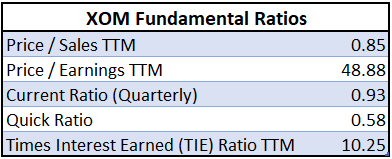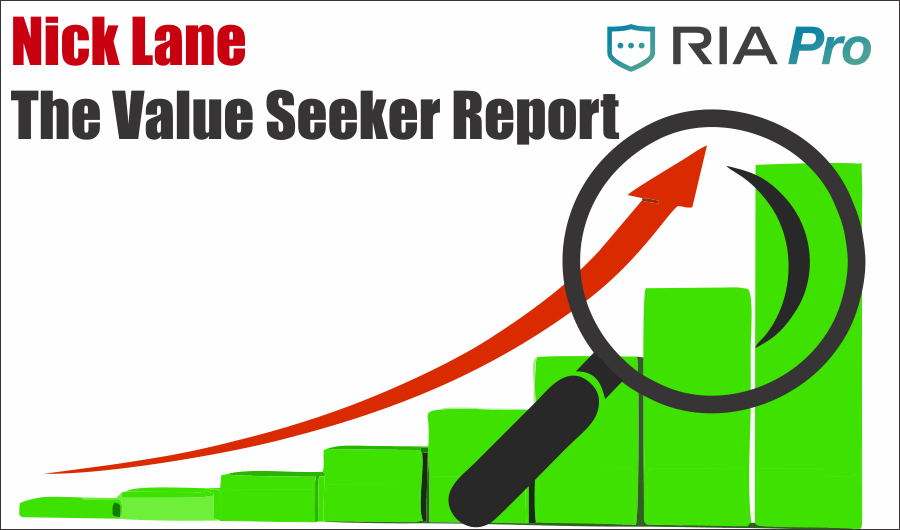In this edition of the Value Seeker Report we analyze an investment opportunity in Exxon Mobil (NYSE: XOM) using fundamental and technical analysis.
Overview
- We utilize RIA Advisors’ Discounted Cash Flow (DCF) valuation model to evaluate the investment merits of Exxon Mobil (NYSE: XOM). Our model is based on our forecasts of free cash flow over the next ten years.
- Using what we view as conservative forecasts, we arrive at an intrinsic value of $55.42 per share for XOM’s stock. The stock is currently trading at $44.51.
Pros
- Since the beginning of the COVID-19 pandemic, XOM has consistently under-performed the market. The stock still has almost 59% upside before it hits its 52-week high. Although we don’t expect XOM’s stock to climb back to its 52-week high, it helps demonstrate the conservatism in our forecasts.
- XOM has increased its dividend in each of the last 37 consecutive years. As a result, XOM has entrenched itself as a staple “widows and orphans” stock and remains committed to its dividend. The stock currently offers a dividend yield of 7.95%.
- XOM will undoubtedly see a shortage of cash flow in 2020. Fortunately, the proceeds from its recent debt issuance should allow the firm to maintain the current dividend for the forecast 10-year period.
- XOM has a very healthy Times Interest Earned (TIE) ratio of 10.25, which means it has the capacity to take on more debt should leadership deem it necessary.


Cons
- XOM currently trades at a Price to Earnings (P/E – TTM) ratio of 48.9, which is much higher than it’s been over the last 20 years. We expect the ratio to retreat to historical levels as earnings normalize. However, a resurgence in COVID-19 cases, vaccine delay, or other drag on economic recovery could result in an elevated P/E ratio for longer than expected.
- The recent crude price war between Saudi Arabia and Russia poses a risk to the path of the recovery in energy prices. At any point, the recovery in crude prices could be halted or even reversed by a supply glut.
- Future global policies geared toward protecting the environment may impose significant costs on XOM, leading to lower profit margins.

Key Assumptions
- Our forecasts are based, in part, on XOM’s 2019 Global Business Outlook, a relatively stable price of oil, and reflect our view of XOM’s path to recovery.
- XOM will see revenue decline substantially in 2020 and face a multi-year recovery in commodity prices. We expect XOM’s revenue to reach 2019 levels by the end of 2023.
- Although XOM has demonstrated industry leading cost discipline, its profit margin will be pressured in 2020. As global demand for energy recovers, XOM will see its profit margin recover. The profit margin will peak in 2023, then decrease slightly to its long-term forecast by 2026.
- Over the forecast 10-year period, the firm will continue to make the capital expenditures necessary to acquire and develop assets in both its upstream and downstream portfolios.


Technical Snapshot
- XOM is testing resistance at the 50-day moving average ($44.50). The stock has some support around $42.35 and more substantial support around $40.25, which could potentially serve as a stop-loss for investors. Above the 50-day moving average XOM should find resistance at $47.50 and the 200-day moving average.
- XOM worked off some of its overbought condition over the last few days, but has largely been range-bound since May.
Value Seeker Report Conclusion On XOM
- According to our forecasts, XOM is currently 23.3% undervalued by the market.
- XOM has failed to recover due to a sharp decrease in commodity prices and the possibility the firm will be forced to cut its dividend. If the firm is able to hold its dividend at $3.48 per share despite sizable cuts by other oil & gas majors, we could see out-performance from the stock.
- We expect XOM will be able to sustain its current dividend unless the economy deteriorates significantly and/or the price of oil collapses.


